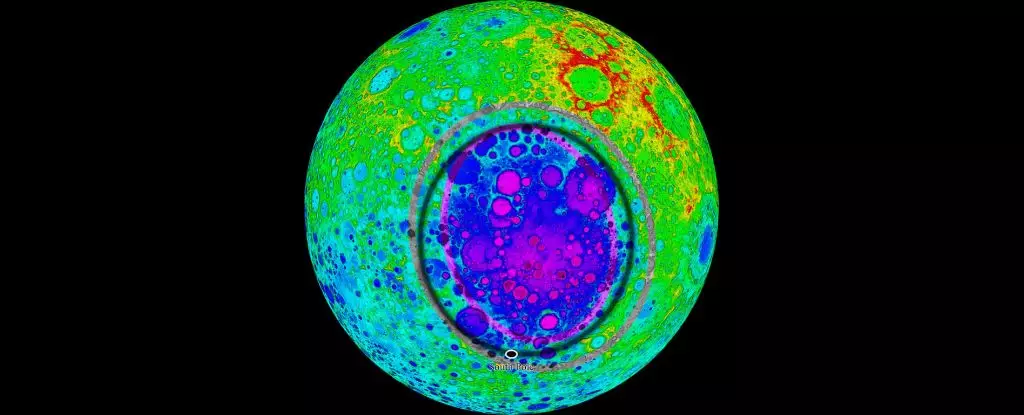The surface of the Moon, adorned with countless craters and scars, reveals a deep and tumultuous history that has been sculpted over billions of years. Among these geological features lies the South Pole-Aitken basin (SPA), one of the largest impact craters not only on the Moon but within the entire Solar System. Spanning a staggering diameter of approximately 2,500 kilometers (1,550 miles), this colossal formation has intrigued scientists for decades as they attempt to unlock its secrets. A recent shift in our understanding of how this basin formed could have profound implications for future lunar exploration missions.
The South Pole-Aitken basin’s immense size and ancient age present considerable challenges for researchers hoping to study its characteristics and origins. Formed over 4 billion years ago, this crater has undergone significant alterations due to subsequent impacts, making its original structure difficult to discern. As geologist Hannes Bernhardt from the University of Maryland notes, comprehensively analyzing the basin remains a daunting task. This research not only questions prevailing theories but also brings us closer to understanding the Moon’s formative years and its subsequent evolution.
Traditional models posited that the SPA was the result of an oblique impact, whereby a large object struck the Moon at a shallow angle, leading to a distinctly oval crater shape. This perspective suggested that the debris resulting from this collision primarily dispersed in a direction away from the lunar south pole. However, recent studies are prompting scientists to reconsider this attribution.
With the benefit of modern technology, researchers utilized data collected by NASA’s Lunar Reconnaissance Orbiter (LRO), which has been surveying the Moon since 2009. This spacecraft has meticulously mapped the lunar surface, providing critical insights into its geology. Bernhardt and his team directed their efforts towards assessing over 200 mountain features around the basin’s perimeter that could potentially represent remnants of the crater’s rim.
Upon completion of their systematic mapping and cataloging, researchers were astonished to find that the features formed a shape that was more circular than previously anticipated. This unexpected circularity indicates a pivotal shift in understanding the dynamics of the impact event.
According to Bernhardt, the newly observed rounder shape suggests that the object that created the crater struck the Moon more vertically, akin to dropping a rock directly onto a surface. This revelation implies a more uniform distribution of debris around the impact site than earlier theories had proposed, potentially enabling future Artemis missions—or possible lunar robotics—to access rare geological materials nestled deep within the Moon’s crust or mantle.
This access to primordial materials is invaluable for understanding the Moon’s formation and development, a subject shrouded in scientific intrigue. While the prevailing theory suggests that the Moon may have formed as a result of a catastrophic collision in the early Solar System, alternatives have emerged, including the concept of coalescing debris or even gravitational capture from another celestial body. The new perspective on the impact angle opens additional avenues for exploration into the Moon’s complex history.
Exploring the South Pole-Aitken basin may yield insights not only into the impact event itself but also into intriguing geophysical characteristics of the Moon. Measurements reveal a striking difference in density beneath the basin, suggesting that a substantial, denser material—perhaps remnants from an ancient asteroid—could reside deep within the crater. Accessing these resources offers a unique opportunity to study minerals from the early solar era, potentially unlocking new knowledge about the origins of the Moon.
As research continues, the implications of these findings extend well beyond academic interest. The Moon stands as a critical area for future exploration, enabling humanity to address fundamental questions about our planetary neighborhood and its formation. According to Bernhardt, this research not only furthers our comprehension of the Moon’s geological history but also equips upcoming missions with guidance on optimal landing sites and research objectives.
The South Pole-Aitken basin embodies the Moon’s rich narrative, and ongoing research has the potential to reshape our understanding of this formidable lunar feature. As scientists grapple with new evidence that suggests a vertical impact nature complicating previous theories, the prospect of accessing previously unreachable materials becomes a tantalizing reality. These developments could assist not only in answering pressing geological questions but also in paving the way for future exploration endeavors beyond our home planet. Thus, the Moon’s surface, with all its scars, continues to tell the story of our solar system’s past, beckoning researchers and explorers alike to unravel its mysteries.


Leave a Reply